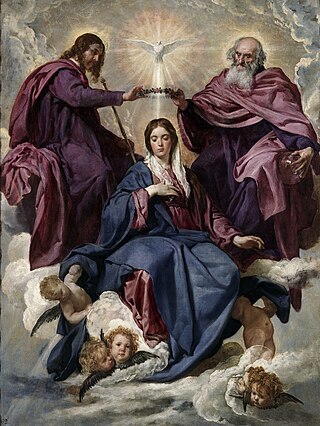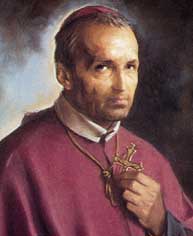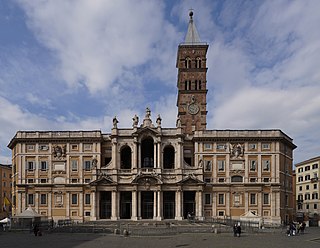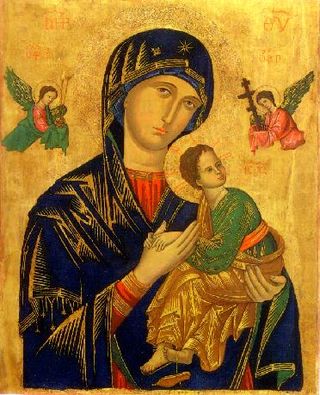
In art, a Madonna is a representation of Mary, either alone or with her child Jesus. These images are central icons for both the Catholic and Orthodox churches. The word is from Italian ma donna 'my lady' (archaic). The Madonna and Child type is very prevalent in Christian iconography, divided into many traditional subtypes especially in Eastern Orthodox iconography, often known after the location of a notable icon of the type, such as the Theotokos of Vladimir, Agiosoritissa, Blachernitissa, etc., or descriptive of the depicted posture, as in Hodegetria, Eleusa, etc.

Queen of Heaven is a title given to the Virgin Mary, by Christians mainly of the Catholic Church and, to a lesser extent, in Anglicanism, Lutheranism, and Eastern Orthodoxy. The title has long been a tradition, included in prayers and devotional literature and seen in Western art in the subject of the Coronation of the Virgin from the High Middle Ages, long before it was given a formal definition status by the Church.

Alphonsus Liguori, CSsR, sometimes called Alphonsus Maria de Liguori or Saint Alphonsus Liguori, was an Italian Catholic bishop, spiritual writer, composer, musician, artist, poet, lawyer, scholastic philosopher, and theologian. He founded the Congregation of the Most Holy Redeemer, known as the Redemptorists, in November 1732.

The Basilica of Santa Maria in Trastevere ; English: Our Lady in Trastevere) is a titular minor basilica in the Trastevere district of Rome, and one of the oldest churches of Rome. The basic floor plan and wall structure of the church date back to the 340s, and much of the structure to 1140–43. The first sanctuary was built in 221 and 227 by Pope Callixtus I and later completed by Pope Julius I. The church has large areas of important mosaics from the late 13th century by Pietro Cavallini.

Marian devotions are external pious practices directed to the person of Mary, mother of God, by members of certain Christian traditions. They are performed in Catholicism, High Church Lutheranism, Anglo-Catholicism, Eastern Orthodoxy and Oriental Orthodoxy, but generally rejected in other Christian denominations.

Acquafondata is a comune (municipality) in the province of Frosinone, in the Italian region of Lazio, located in the Monti della Meta area, about 130 kilometres (81 mi) southeast of Rome and about 50 kilometres (31 mi) east of Frosinone.

A canonical coronation is a pious institutional act of the pope, duly expressed in a formal decree of a papal bull, in which the pope bestows the pontifical right to impose an ornamental crown, a diadem or an aureole to an image of Christ, Mary or Joseph that is widely venerated in a particular diocese or locality.

Our Lady of Good Counsel is a title given to the Blessed Virgin Mary, after a painting said to be miraculous, now found in the thirteenth century Augustinian church at Genazzano, near Rome, Italy. Measuring 40 to 45 centimetres the image is a fresco executed on a thin layer of plaster no thicker than an egg shell. Over the centuries, devotions to Our Lady of the Good Counsel grew among saints and Popes, to the extent that a reference to it was added to the Litany of Loreto and the devotion spread throughout the world. Her feast day is 26 April.

Our Lady of Graces or Saint Mary of Graces is a devotion to the Virgin Mary in the Roman Catholic Church. Several churches with this dedication often owe their foundation to thankfulness for graces received from the Virgin Mary, and are particularly numerous in Italy, India, Australia, United States, Portugal, France and the Italian-speaking region of Switzerland. Also it is related to the Marian apparitions in which was revealed the Miraculous Medal, also known as the Medal of Our Lady of Graces.

Mary, the mother of Jesus in Christianity, is known by many different titles, epithets, invocations, and several names associated with places.

The veneration of Mary in the Catholic Church encompasses various devotions which include prayer, pious acts, visual arts, poetry, and music devoted to her. Popes have encouraged it, while also taking steps to reform some manifestations of it. The Holy See has insisted on the importance of distinguishing "true from false devotion, and authentic doctrine from its deformations by excess or defect". There are significantly more titles, feasts, and venerative Marian practices among Roman Catholics than in other Western Christian traditions. The term hyperdulia indicates the special veneration due to Mary, greater than the ordinary dulia for other saints, but utterly unlike the latria due only to God.

Catholic Marian churches are religious buildings dedicated to the veneration of the Blessed Virgin Mary. These churches were built throughout the history of the Catholic Church, and today they can be found on every continent including Antarctica. The history of Marian church architecture tells the unfolding story of the development of Catholic Mariology.

Mary has been one of the major subjects of Western Art for centuries. There is an enormous quantity of Marian art in the Catholic Church, covering both devotional subjects such as the Virgin and Child and a range of narrative subjects from the Life of the Virgin, often arranged in cycles. Most medieval painters, and from the Reformation to about 1800 most from Catholic countries, have produced works, including old masters such as Michelangelo and Botticelli.

"Immaculate Mary" or "Immaculate Mother" is a popular Roman Catholic Marian hymn. It is also known as the Lourdes Hymn, a term which also refers to the hymn tune itself. It is often sung in honour of the Immaculate Conception of the Blessed Virgin Mary.

Our Lady of Providence or Our Lady of Divine Providence is a title of Mary. Her feast day is celebrated on 19 November.

Santuario della Madonna del Divino Amore, or the Shrine of Our Lady of Divine Love, is a Roman Catholic shrine in the southern outskirts of Rome dedicated to the Blessed Virgin Mary that consists of two churches: an old church built in 1745 and a new church added to the sanctuary in 1999. The church was included by Pope John Paul II in the pilgrimage of Seven Pilgrim Churches of Rome during the Holy Year 2000.

Maria Santissima dell'Udienza or Madona dell'Udienza or Our Lady of the Audience is a marble sculpture created by the Renaissance sculptor Antonello Gagini, in the early 1500s. The statue is currently housed in the apse of the Sanctuary of Our Lady of the Audience in Sambuca di Sicilia, Italy.

The Sanctuary of Madonna dei Miracoli is a church in Alcamo, province of Trapani, Sicily, southern Italy; it is dedicated to the Madonna of the Miracles.

The Sanctuary of the Most Holy Mary of the Height is a place of Marian devotion, located on the top of Mount Bonifato, in Alcamo in the province of Trapani, Italy.

Our Lady of Consolation or Mary, Comforter of the Afflicted is a title of the Blessed Virgin Mary and venerated in the Roman Catholic Church.




















